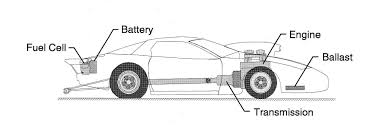
Weight distribution is one of the most critical factors in optimizing a car’s performance, and for a brand like Ferrari, renowned for its engineering precision and high-performance sports cars, it is an essential aspect that cannot be overlooked. Ferrari’s expertise in weight distribution not only enhances the car's handling and stability but also contributes to its speed, fuel efficiency, and overall driving experience.
In this article, we explore how Ferrari achieves optimal weight distribution in its cars and why this engineering aspect is key to the brand’s success on both the road and track.
1. The Role of Weight Distribution in Performance
Weight distribution is the way a car’s mass is spread across its chassis, affecting how the car behaves under different driving conditions. Ferrari pays meticulous attention to this, aiming for a near 50/50 weight distribution between the front and rear axles. This balance ensures that the car performs optimally when cornering, braking, and accelerating.
With even weight distribution, Ferrari cars achieve improved stability, especially when cornering at high speeds. An imbalance in weight can lead to poor handling, reduced traction, and an overall sluggish performance. Ferrari's engineers optimize the position of key components like the engine, transmission, and fuel tank to achieve the ideal balance of weight across the car’s frame.
2. Mid-Engine Layout: Ferrari’s Signature Design
One of the most distinctive features of many Ferrari models is the mid-engine layout. By placing the engine near the center of the car, Ferrari improves the car’s weight distribution and handling dynamics. This configuration allows for a more neutral balance between the front and rear axles, giving the driver greater control, especially when navigating sharp corners or high-speed maneuvers.
The mid-engine layout has been a hallmark of Ferrari’s high-performance cars, including the Ferrari 488 GTB and Ferrari F8 Tributo. This design reduces the moment of inertia and increases the car’s agility, making Ferrari cars renowned for their precise handling and cornering capabilities.
3. Lightweight Materials for Better Weight Balance
Ferrari uses lightweight materials like carbon fiber, aluminum, and titanium in the construction of its cars. These materials allow Ferrari engineers to fine-tune the weight distribution without compromising on strength or safety. By using such advanced materials, Ferrari reduces the overall weight of the car, which not only improves acceleration but also enhances fuel efficiency and braking performance.
The use of carbon fiber in the body panels and other parts helps to offset the weight of components like the engine, ensuring that the overall mass of the car is kept in balance. The lightweight materials further improve the car’s dynamic performance, making Ferrari models some of the fastest and most responsive cars on the market.
4. Dynamic Weight Distribution in Ferrari’s Sports Cars
While static weight distribution is important, Ferrari also focuses on dynamic weight distribution—how the weight shifts when the car accelerates, brakes, or corners. Active suspension systems and electronic stability control are integrated into Ferrari models to ensure that weight distribution remains optimal throughout different driving conditions.
For example, in the Ferrari 812 Superfast, the magnetic shock absorbers adjust the car’s suspension dynamically to compensate for changes in weight distribution as the car accelerates or brakes. This ensures that the car remains stable and responsive even at high speeds or during aggressive driving.
5. Impact on Ferrari’s Racing Success
Ferrari’s understanding of weight distribution has been critical in its racing success. In Formula 1, Ferrari has dominated with a precise understanding of how weight balance affects the car’s ability to handle high-speed turns, braking zones, and acceleration. This understanding is directly translated into the design of Ferrari’s road cars.
Ferrari’s racing technology, including the use of lightweight components, low center of gravity, and optimal mass distribution, has influenced the design of their production cars, ensuring they offer exceptional performance not just on the track, but on everyday roads as well.
6. The Ferrari 488 Pista: A Case Study
A perfect example of Ferrari’s mastery of weight distribution is the Ferrari 488 Pista. The 488 Pista features a V8 twin-turbocharged engine mounted in a mid-engine layout, providing a near-perfect balance of weight between the front and rear axles. This setup allows for incredible agility, enabling the car to achieve top speeds while maintaining maximum stability.
The car also features lightweight carbon fiber components, titanium exhaust systems, and advanced aerodynamics, all contributing to its ability to maintain superior weight distribution while maximizing performance. The 488 Pista’s success on both the track and road can be attributed to its precision-engineered weight distribution.
7. Ferrari’s Future: Continued Focus on Weight Distribution
As Ferrari continues to innovate, weight distribution will remain a key focus in their future models. With the introduction of electric and hybrid vehicles, such as the SF90 Stradale, Ferrari will continue to refine its weight distribution strategies to accommodate new powertrains. Ensuring a balanced weight distribution is vital for maintaining driving dynamics, especially with the added complexity of battery and motor systems.
The challenge for Ferrari will be to optimize weight distribution while incorporating new technologies, such as electrification, without compromising performance. Ferrari’s commitment to advanced engineering ensures that weight distribution will continue to play a major role in the brand’s future developments.

0 Comments
Post Comment